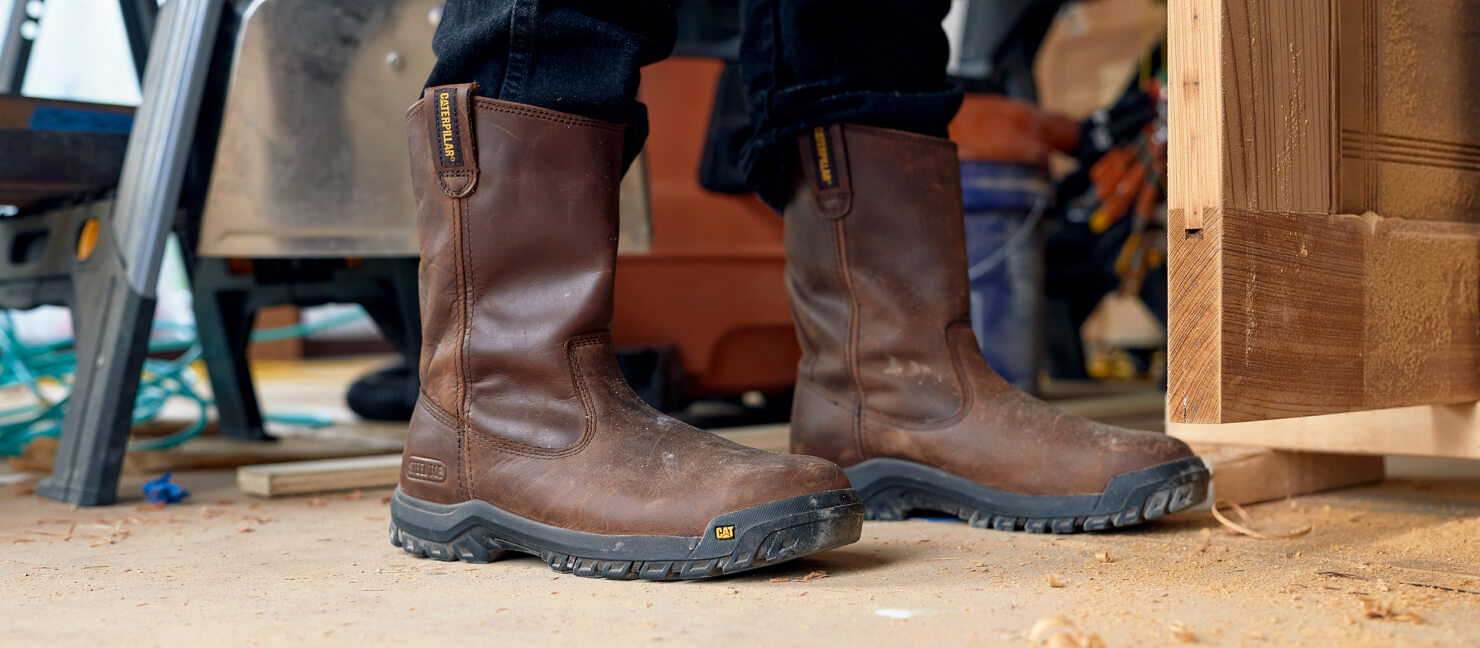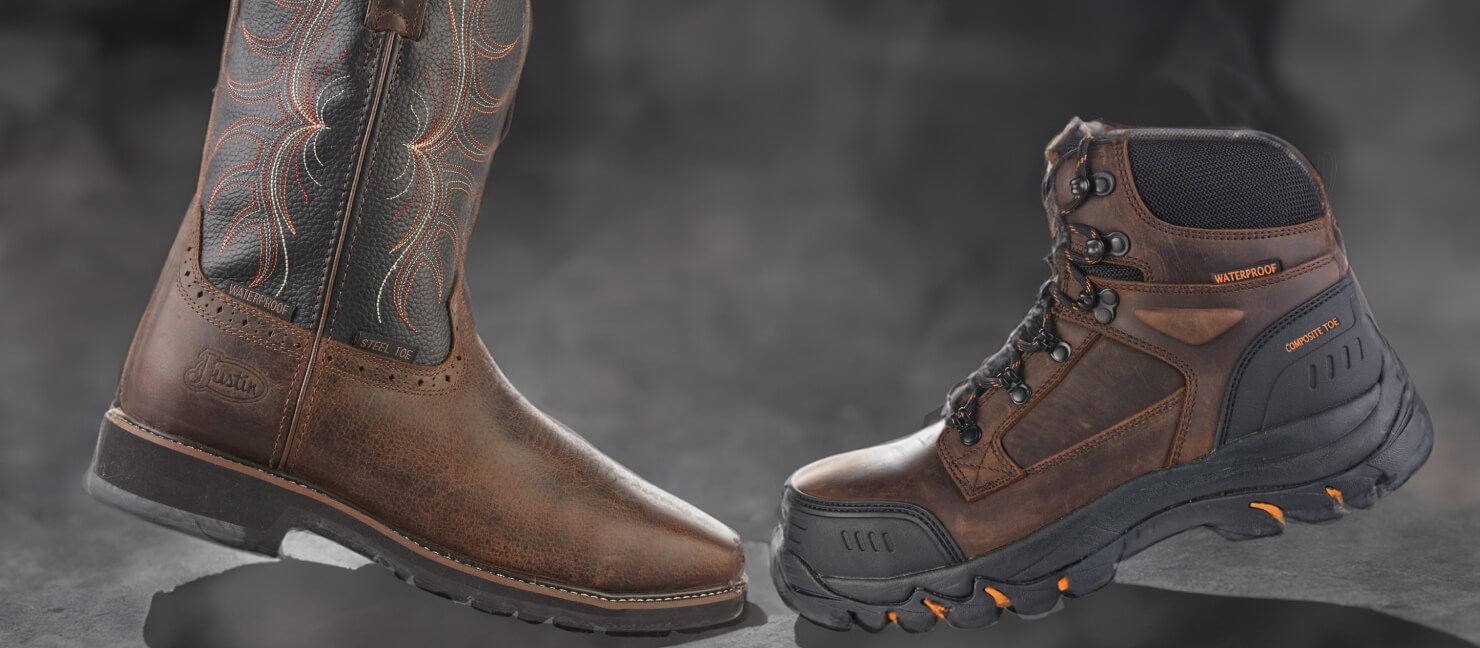Battle of the Boots: Composite Toe vs Steel Toe

Are you stepping into a new job in construction, manufacturing, or any field requiring protective footwear but uncertain whether to purchase steel-toe boots or composite-toe boots? This complete guide gives you everything you need to make an informed decision and ensure your feet stay comfy and protected on the job.
Key Takeaways
- Composite Toe vs Steel Toe: What You Need to Know: Both shoes offer protection against most workplace hazards. However, composite boots have extra protection against erosion and heat transfer.
- What Are Steel-Toe Shoes? Steel-toe shoes offer superior protection with a steel cap, ideal for safeguarding against heavy impacts and compression hazards, like construction sites.
- What are Composite-Toe Shoes? Composite-toe shoes provide lightweight, non-metallic protection suitable for work environments with electrical or chemical hazards.
- How Are Composite-Toe Boots Different From Steel-Toe Boots? Composite-toe boots meet similar safety standards as steel-toe boots. However, they feature materials like plastic, Kevlar, or carbon fiber instead of steel.
- Composite Toe vs Steel Toe: Pros and Cons: Steel-toe boots protect against heavier objects but offer limited chemical protection. Composite-toe boots offer protection against electrical hazards but are more expensive.
- Which Boot Is Better for You? Steel-toe boots are ideal for workplaces with heavy and sharp objects. Composite-toe boots are suitable for workplaces with chemical hazards since the material in the toe doesn’t corrode.
- FAQs: Composite-Toe vs Steel-Toe Boots: Learn more about each boot’s durability, cost, and appearance.
Composite Toe vs Steel Toe: What You Need to Know
| Composite Toe vs Steel Toe: Comparison Chart | ||
|---|---|---|
| Category | Composite Toe | Steel Toe |
| Protection | Moderate (meets safety standards but less force resistance) | High (against heavy impact and sharp objects) |
| Durability | Durable | Very durable |
| Waterproofing | Available, often combined with materials that enhance waterproofing | Available in some styles, effectiveness varies |
| Chemical Resistance | Better; less prone to corrosion due to non-metallic nature | Good; could corrode if not properly treated |
| Weight | Lighter | Heavier |
| Cost | More expensive | Generally less expensive |
| Material | Plastic, carbon fiber, or Kevlar | Steel |
| Best For | Environments with more electrical hazards, extreme temperatures, or where less weight and more insulation are important | Environments with high risk of heavy objects falling or rolling onto feet, or where durability and lower cost are needed |
What Are Steel-Toe Shoes?

Steel-toe shoes are a staple in industries where foot protection from falling objects and compression is essential. These boots feature a protective steel cap to shield the toes from heavy impacts and crushing hazards.
Their robust defense ensures that workers in construction, manufacturing, and other hazardous environments have the necessary protection. Steel-toe boots are generally more affordable compared to other protective footwear options. The cost-effectiveness of steel makes these boots a widely accessible choice for a diverse range of workers.
However, the metal in these boots has conductive properties that cause cold or heat transfer in extreme temperatures. These properties can cause the boots to become uncomfortable or potentially put wearers at risk in environments with electrical hazards.
The weight of steel-toe boots could lead to increased fatigue during long workdays. Their metallic nature also means that these boots can activate metal detectors in high-security areas where passing through checkpoints is a routine requirement.
What are Composite-Toe Shoes?

Composite-toe shoes offer an innovative solution to the drawbacks of traditional steel-toe boots. These shoes contain non-metallic materials such as Kevlar, carbon fiber, and plastic. These materials provide protection in hazardous environments while reducing the shoe’s weight. The lighter construction minimizes foot fatigue and makes composite boots preferred for workers facing long shifts.
The non-metallic nature of a composite toe also provides advantages such as better insulation against extreme temperatures and safety in electrical hazard situations where non-conductive footwear is needed. However, the high-tech materials and manufacturing used for composite boots often result in this style of shoe being more expensive to purchase.
How Are Composite-Toe Boots Different From Steel-Toe Boots?
Both composite and steel-toe boots offer safety features tailored to various work environments. However, they have different construction, materials, and overall performance characteristics that cater to distinct needs and preferences. Understanding these differences can help you choose the best boot for your work conditions and requirements.
Materials
Composite-toe boots contain non-metallic materials such as Kevlar, carbon fiber, or plastic. They offer a strong and lightweight alternative for foot protection. On the other hand, steel-toe boots incorporate a steel cap inserted into the toe box to shield the feet from injury. The materials in each boot significantly affect the weight, comfort, and suitability for various work environments.
Weight
One of the most noticeable differences between composite and steel-toe boots is their weight. Composite boots are significantly lighter, which can be beneficial for workers who spend long hours on their feet. Lighter boots help minimize fatigue. This makes composite boots preferable for professionals prioritizing comfort and endurance throughout the workday.
Thermal and Electrical Insulation
Composite boots excel in environments where thermal and electrical insulation is a concern. Steel-toe boots can conduct heat, cold, and electricity; however, check the product description for electrical protection. Added insulation makes composite boots safer for individuals working in extreme temperatures or areas with chemical hazards.
Waterproofing
Both composite and steel-toe boots can be waterproof, but the effectiveness of waterproofing depends on the construction materials and design. Manufacturers may apply waterproof membranes or treatments to the outside of the boot to ensure feet stay dry. Check the product description to see which styles offer this feature.
Slip Resistance
Slip resistance is vital for safety in environments where oil, water, or other substances are present. Many composite and steel-toe boot styles both offer slip-resistant outsoles to provide better grip and stability on wet, oily, or slippery surfaces.
Chemical Resistance
Both composite-toe and steel-toe boots come in chemical-resistant styles. However, composite boots are less likely to corrode or rust due to their non-metallic construction. Steel-toe boots can be chemically resistant if coated with special materials. Check the boot's specifications for chemical resistance ratings to ensure adequate protection in hazardous environments.
Cost
The advanced materials and manufacturing process required for composite boots usually results in a higher price point compared to traditional steel-toe boots. Steel-toe boots are generally more cost-effective while providing robust protection.
Composite Toe vs Steel Toe: Pros & Cons
Depending on your workplace or lifestyle, a steel-toe or composite-toe boot may be a better fit for you. Take a look at the pros and cons of each shoe style to find out which features suit your needs:
Steel Toe Pros
|
Steel Toe Cons
|
Composite Toe Pros
|
Composite Toe Cons
|
Which Boot Is Better for You?

Choosing the proper footwear can impact your protection and comfort on the job. The decision between steel and composite toe boots depends on various factors. These considerations include workplace hazards, comfort requirements, and personal preferences. Understanding their specific advantages can help you pick the best boots.
Safety Standards
Both steel and composite toe boots undergo rigorous testing for impact and compression resistance under the ASTM F2412 and F2413 standards. These standards ensure that the footwear provides a certified level of protection against these hazards regardless of the material.
When shopping for boots, check for the compliance rating required by your workplace. These may include ASTM, EH (electrical hazard), slip resistance, and waterproofing. These standards confirm whether the boots come with specific safety features. Selecting boots that meet certain workplace requirements is crucial for your protection.
When to Choose Steel-Toe Boots
Steel-toe boots are the top choice for environments requiring protection from falling objects and compression hazards. Their robust construction makes them ideal for industrial settings. These boots are also more affordable. Steel boots may offer the best safety, durability, and value if your work environment does not expose you to electrical hazards or extreme temperatures.
When to Choose Composite Boots
Composite-toe boots are advantageous in work environments with diverse hazards. The non-conductive materials offer an essential layer of protection in environments with more exposure to electrical risks. Composite boots also provide better insulation in workplaces with extreme temperatures. Their lightweight nature also significantly reduces fatigue on the job.
While generally more expensive, the benefits of composite boots make them a worthy investment for workers facing specific occupational hazards.
FAQs: Composite-Toe vs Steel-Toe Boots
-
Are steel-toe boots more durable than composite-toe boots?
Steel-toe boots are generally considered more durable due to their metal construction, which can withstand higher levels of force and wear on the front of the shoe. However, they are more likely to corrode in environments with repeat chemical exposure. -
Why are composite-toe boots more expensive than steel-toe boots?
Composite-toe boots are more expensive due to the cost of the high-tech materials used, such as carbon fiber, Kevlar, or plastic. These materials provide non-corrosive, non-conductive, and lightweight protection with additional features like electrical or cold-temperature insulation. -
Do composite-toe boots look bulkier than steel-toe boots?
Despite appearing bulkier, composite-toe boots are lighter-weight than steel-toe boots. Composite toe boots weigh less because they use non-metallic materials.
Have Fun Out There!
Ready to level up your work gear with the right protective footwear? Look no further than Academy Sports + Outdoors! Explore our extensive selection of composite-toe boots and shoes and steel-toe boots and shoes to find the perfect blend of safety, comfort, and durability for your workday needs. Your feet deserve the best protection, and we're here to provide it!


